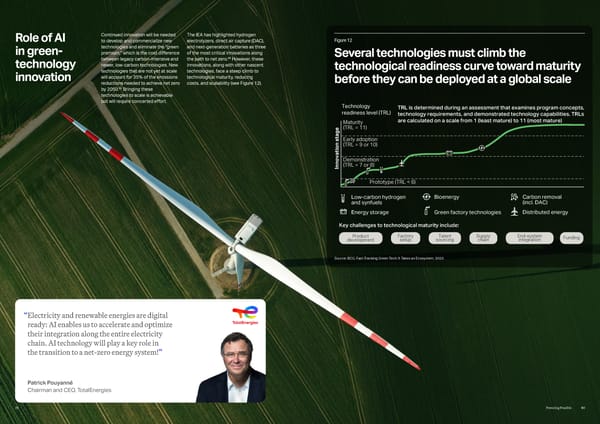Role of AI in green- technology innovation Figure 12 Several technologies must climb the technological readiness curve toward maturity before they can be deployed at a global scale Continued innovation will be needed to develop and commercialize new technologies and eliminate the “green premium,” which is the cost difference between legacy carbon-intensive and newer, low-carbon technologies. New technologies that are not yet at scale will account for 35% of the emissions reductions needed to achieve net zero by 2050.65 Bringing these technologies to scale is achievable but will require concerted effort. Innovation stage Demonstration (TRL = 7 or 8) Prototype (TRL < 6) Early adoption (TRL = 9 or 10) Maturity (TRL = 11) Technology readiness level (TRL) TRL is determined during an assessment that examines program concepts, technology requirements, and demonstrated technology capabilities. TRLs are calculated on a scale from 1 (least mature) to 11 (most mature) Low-carbon hydrogen and synfuels Bioenergy Energy storage Carbon removal (incl. DAC) Green factory technologies Distributed energy Key challenges to technological maturity include: Funding End-system integration Supply chain Talent sourcing Factory setup Product development Patrick Pouyanné Chairman and CEO, TotalEnergies “ Electricity and renewable energies are digital ready: AI enables us to accelerate and optimize their integration along the entire electricity chain. AI technology will play a key role in the transition to a net-zero energy system!” The IEA has highlighted hydrogen electrolyzers, direct air capture (DAC), and next-generation batteries as three of the most critical innovations along the path to net zero.66 However, these innovations, along with other nascent technologies, face a steep climb to technological maturity, reducing costs, and scalability (see Figure 12). Source: BCG, Fast-Tracking Green Tech: It Takes an Ecosystem, 2023. 40 Powering Possible 39
 Powering Possible 2024: AI and Energy for a Sustainable Future Page 20 Page 22
Powering Possible 2024: AI and Energy for a Sustainable Future Page 20 Page 22